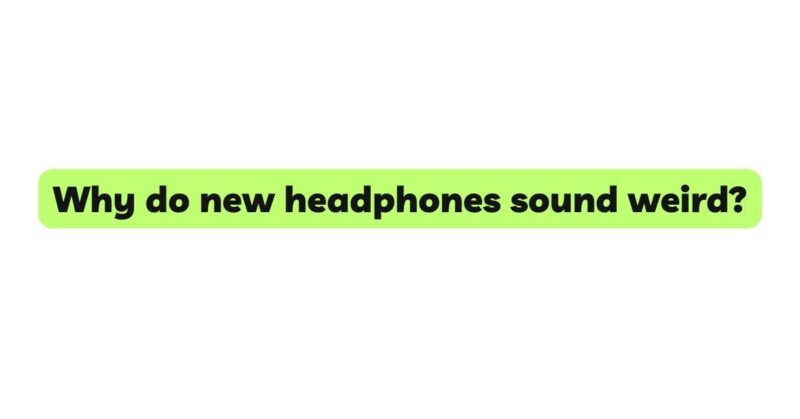Purchasing a new pair of headphones is an exciting experience, especially for music enthusiasts and audiophiles eagerly awaiting an improved auditory journey. However, many users have reported an unusual phenomenon – new headphones sounding weird or different from what they expected. This occurrence can be puzzling and sometimes disappointing, leaving users questioning the quality of their purchase. In this article, we aim to explore the reasons behind why new headphones sound weird, understanding the factors that contribute to this phenomenon and providing insights to help users optimize their audio experience.
- Breaking-In Period:
One of the primary reasons new headphones may sound weird is the breaking-in period. Just like any new audio equipment, headphones need time to settle and reach their optimal performance level. During this period, the diaphragms, drivers, and other components undergo slight adjustments as they adapt to the signals passing through them.
The breaking-in period can range from several hours to several days, depending on the model and brand of the headphones. During this time, the sound may initially seem different or strange to the user. However, with continued use, the headphones gradually reach their full potential, and the sound quality stabilizes.
- Adjusting to Sound Signature:
Each pair of headphones has its unique sound signature, representing the way the headphone manufacturer has tuned the audio response. When transitioning from old headphones to new ones, users may notice a significant difference in the sound signature. This change can initially make the new headphones sound weird or unfamiliar, as the user’s ears are accustomed to the sound of their previous headphones.
The brain is excellent at adapting to familiar sound signatures, and any deviation from the norm may take time to get used to. With prolonged use, the brain will adjust to the new sound signature, and the headphones will sound more natural and pleasing to the user.
- Ear Pad Compression:
For over-ear and on-ear headphones, the ear pads play a crucial role in sound isolation and comfort. New headphones often come with fresh ear pads that have not yet conformed to the user’s ears. As a result, the ear pads may not create a proper seal around the ears, leading to sound leakage and a change in sound quality.
The lack of a proper seal can result in an unbalanced frequency response, making the sound seem weird or distorted. Over time, as the ear pads conform to the user’s ears, the seal improves, and the sound quality becomes more consistent.
- Cable and Connector Issues:
In some cases, new headphones may exhibit sound anomalies due to cable or connector issues. Poor connections or defective cables can cause intermittent audio disruptions, leading to weird sound experiences. Additionally, low-quality cables may introduce interference or signal degradation, affecting the overall sound quality.
Inspecting the headphone cables and connectors for any visible defects or damage and ensuring a secure connection can help resolve sound irregularities caused by cable-related issues.
- Ear Fatigue:
Listening to new headphones for an extended period without giving the ears sufficient breaks can lead to ear fatigue. When the ears are overworked, they become less sensitive to certain frequencies, leading to a perception of the sound being weird or off. This phenomenon is particularly common in over-ear headphones, where the ear cups may apply pressure to the ears.
Taking short breaks during the initial use of new headphones can help prevent ear fatigue and provide the ears with time to adjust to the new sound signature.
- Perception Bias:
Perception bias can also contribute to the perception that new headphones sound weird. Users may have high expectations based on reviews, recommendations, or previous experiences with other headphones. When the actual sound of the new headphones does not match these expectations, users may perceive it as strange or disappointing.
To mitigate perception bias, it is essential to approach new headphones with an open mind and allow time for the brain to adjust to the new sound signature.
Conclusion:
In conclusion, the phenomenon of new headphones sounding weird can be attributed to various factors, including the breaking-in period, adjustment to the sound signature, ear pad compression, cable and connector issues, ear fatigue, and perception bias. Understanding these factors can help users optimize their audio experience and prevent unnecessary disappointment or confusion.
For those experiencing sound irregularities with new headphones, it is crucial to be patient and allow the headphones to go through the breaking-in period. Additionally, ensuring proper ear pad fit and inspecting the cables and connectors for any issues can help eliminate sound anomalies.
Ultimately, each pair of headphones is unique, and it is essential to give them time to reveal their true sonic potential. By giving new headphones the opportunity to settle and allowing the brain to adapt to the new sound signature, users can fully enjoy the auditory journey these new audio companions have to offer.

